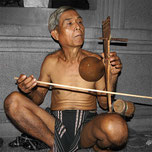Last update : December 5, 2023
This page offers a general introduction to gong ensembles and bamboo instruments in Asia, followed by links to ethnic minority instruments from Ratanakiri and Mondulkiri.
Generalities
The ethnic minorities of Ratanakiri and Mondulkiri share the playing of gong ensembles and bamboo instruments. As an introduction, we offer you two films made by Sounds of Angkor.
Gongs of every power
Film directed by Patrick Kersalé in 2004 among ethnic minorities in Vietnam and Laos.
The political borders of Laos, Cambodia and Vietnam separate peoples who speak Austronesian and Austro-Asiatic languages, who once lived in the forest, practicing slash-and-burn agriculture and training elephants. These peoples share an instrumental heritage: playing gongs. Music of gongs has a power over the mind, the spirit, a power that influences each person’s destiny. In spite of the Communist revolution, the war and the disappearance of vast portions of the forest, these people continue striking their gongs.
But the spirit animating this music has changed and, today, these instruments are the object of an altogether different power.
Despite the communist revolution, the war and the disappearance of much of the forest, these peoples continue to strike the gongs. But the spirit that animated this music has changed and today these instruments are the object of a whole new power ...
Le chant du bambou (The bamboo song)
Film (in French) directed by Patrick Kersalé in 2005 among minorities in China, Laos and Vietnam.
The ethnic minorities inhabiting southern China and the former Indochina territories have a rich heritage of bamboo musical instruments, the craftsmanship and style of play of which are the fruit of millennial traditions. A snapshot of this musical instrument makes it possible to distinguish the strata of a development made up of founding innovations and adaptations testifying to both cultural mixtures and isolates.
Bamboos struck, blown bamboos, bamboos with strings, a whole range of sound tools at the service of human communication and relations with the world of the invisible. Beyond history and archaeology, the showcase of the present time offers us to contemplate the stages of the creation of this heritage which, today as in the past, continues to adapt to the needs of society.
Musical instruments
In 5 minutes, discover the main musical instruments of the ethnic minorities of Ratanakiri and Mondulkiri.
Now take your time and learn about the musical instruments of the ethnic minorities of Ratanakiri and Mondulkiri.















